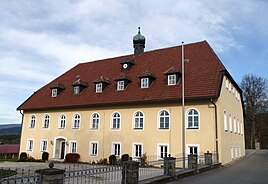Oberfrauenau
|
Oberfrauenau
community Frauenau
Coordinates: 48 ° 59 ′ 54 ″ N , 13 ° 19 ′ 9 ″ E
|
|
|---|---|
| Height : | 714 m above sea level NN |
| Postal code : | 94258 |
| Area code : | 09926 |
|
The manor house (old castle)
|
|
Oberfrauenau is an estate and part of the municipality of Frauenau in the Regen district .
location
Oberfrauenau is about two kilometers northeast of Frauenau.
history
In 1492, Balthasar Phaler sold his existing glassworks to Erasmus Moosberger. In 1605 Paulus Poschinger acquired the Oberfrauenauer Glashüttengut, which has since been associated with the Frauenau branch of the Poschinger family , which has been running the addition of Frauenau since 1901 . The glass factory of Poschingerstraße exists today.
Around 1650 the old castle was built , a manor house that is still the center of the glassworks today. On October 18, 1785, Elector Karl Theodor awarded Georg Benedikt I. Poschinger the lower court court rights and jurisdiction along with the title of nobility. This gave the glassworks property the status of a court brand, with which it fell from the basic sovereignty of the elector and the Rinchnach provost and became the property of the Poschinger.
Around 1825 Georg Benedikt I von Poschinger built a new glassworks, the so-called Neuhütte, near the manor house . On August 16, 1860 this hollow glass factory burned down. Around 1835 Johann Michael von Poschinger built a mirror glass factory and mirror grinding shop on the northeastern edge of Oberfrauenau. After the conversion to hollow glass, glass was manufactured here until 1893.
In 1820 the Hofmark Oberfrauenau became a second class patrimonial court , which was repealed in 1848. In 1863 a Fideikommiss was formed for the undivided and inalienable preservation of the family property.
A bar license was granted in 1860 for the Gutsgasthof, which is still in operation today. In 1878 Gut Oberfrauenau, with 3,476.36 hectares, was the largest manorial estate in the area, before the Oberzwieselau and Buchenau estates, which were also owned by the Poschinger, with 2,209.50 hectares each.
From 1875 to 1884, the New Palace was built according to plans by the Munich architect Albert Schmidt in the neo-renaissance style . This building, adorned with pointed towers and bay windows, was surrounded by a garden, the showpiece of which was a water fountain. The royal gardener Carl von Effner directed the planning of the park . The castle served as a residential building for the Barons von Poschinger until 1945.
After the Second World War, it was made into the US headquarters for the Zwiesel-Frauenau area and later served as an emergency shelter for displaced persons . Hippolyt Freiherr Poschinger von Frauenau offered it to the state for sale in vain because of the damage it had suffered. In 1959, with the approval of the state, he had it dismantled by a force of 50 men from Mountain Pioneer Battalion 8 from Degerndorf (municipality of Brannenburg ). On August 15, 1959, the largest and last of the three towers was blown up. A total of 750 kilograms of explosives were used in 410 operating hours, with 8,500 cm³ of rubble being removed or distributed. Only the castle chapel with the family crypt remained. In the Degerndorfer barracks there are still coffered ceilings and doors of the castle.
Attractions
At the beginning of the 18th century, a 1.7 hectare orchard meadow , which is still present today, was created as part of the palace garden, which was surrounded by a surrounding wall in 1792. The over one hundred fruit trees also bear rare old varieties such as the Bohemian Brünnerling .
There is also a falconry (moved to Ludwigsthal in 2011), a game reserve and, since 2006, a stud with Icelandic horses . Oberfrauenau is also the starting point for hikes, especially to the Frauenau drinking water reservoir and the Großer Rachel .
Web links
literature
- Marita Haller: Dream castle in the forest - the former castle of Barons Poschinger von Frauenau , edition Lichtland, Freyung 2013, ISBN 978-3-942509-27-5



